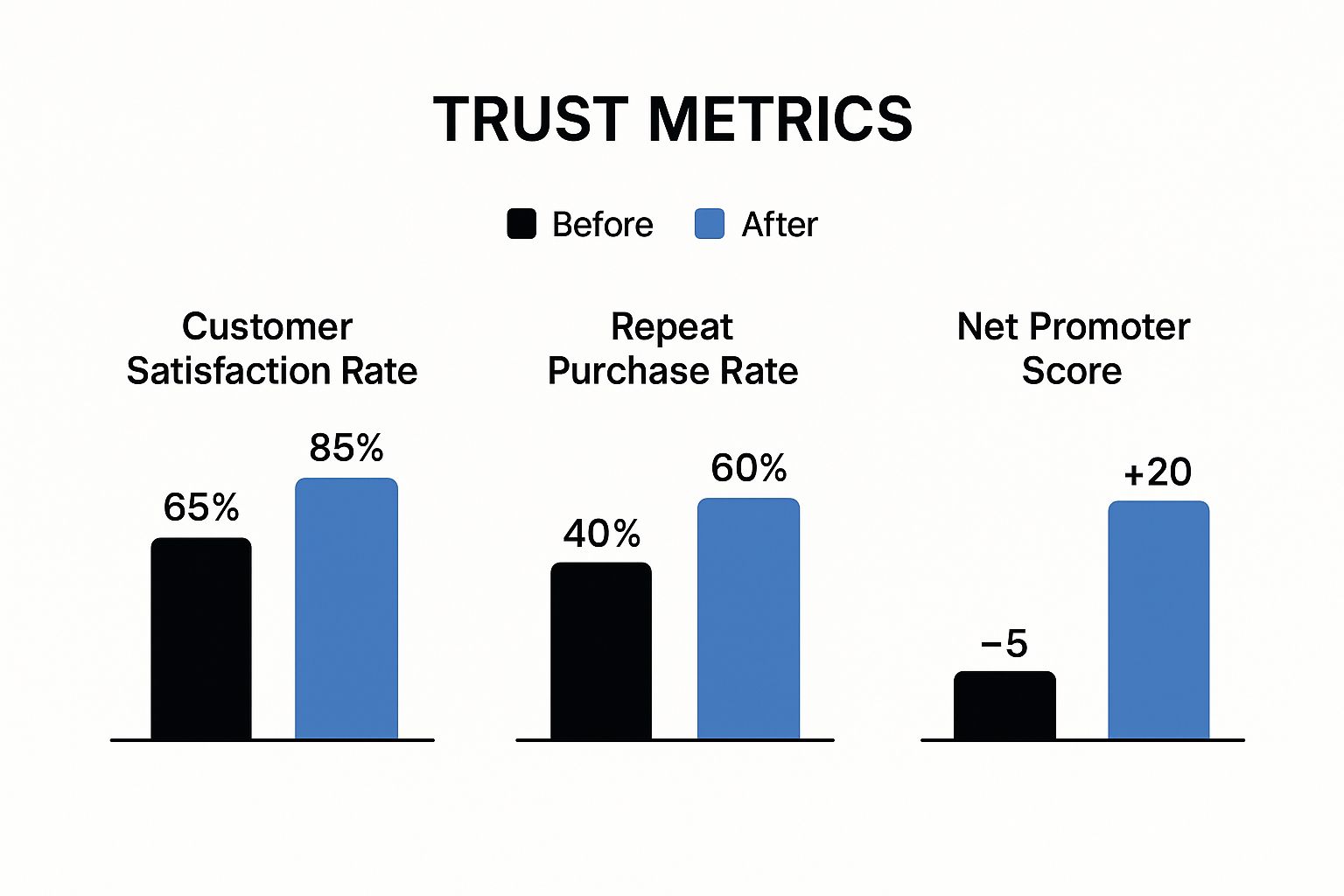Building customer trust isn't some complicated formula. At its core, it's about being consistent, transparent, and keeping the lines of communication wide open. It’s about delivering on your promises, every single time. And when you do occasionally fall short—because everyone does—it's about owning it and being upfront. If you can master these fundamentals, you’ll build the kind of relationships that don’t just create customers, but create advocates for your brand.
Why Customer Trust Is Your Most Valuable Asset
In a market overflowing with options, trust isn't just a "nice-to-have." It's the currency your business runs on. It's that invisible force that convinces a one-time buyer to stick around for the long haul and turns a curious browser into a loyal partner. Without it, even the most brilliant product or service will stall out. Trust is the bedrock of any lasting customer relationship, and it directly fuels loyalty, retention, and, ultimately, your bottom line.
But earning and keeping that trust is tougher than ever. Customers today are savvy and have high expectations. They've seen it all, and they're less forgiving of mistakes. Most of the effective strategies for building real loyalty come back to simple, human principles. As one expert put it, you have to focus on building trust with every customer interaction.
The High Stakes of Broken Trust
Today's customers, especially those who grew up online, see transparency and responsible data handling as the bare minimum. A single slip-up—a data breach, an exaggerated marketing claim, or one really bad customer service interaction—can undo years of hard work in an instant.
The fallout can be swift and severe. You can feel the pressure mounting, with 75% of executives admitting it’s become much harder to maintain customer trust. More importantly, over half of consumers (55%) will walk away from a brand for good after their trust is broken. That number jumps to 60% for Gen Z. These aren't just numbers; they represent real people making real decisions about where to spend their money.
Trust is a powerful business asset. When customers trust your brand, they are more likely to make repeat purchases, refer others, and forgive occasional mistakes. This creates a resilient business model that can weather market changes and competition.
The Core Pillars of Building Trust
To build trust that lasts, you need a solid framework. This entire guide is built on three core pillars that work together to create a brand experience people can count on. Getting these right provides a clear roadmap for everything you do.
Here's a quick look at the pillars we'll be diving into throughout this guide.
The table below provides a high-level overview of the essential strategies we'll explore for earning and maintaining the trust of your customers.
Key Pillars for Building Customer Trust
By focusing your energy on these three areas, you'll shift from just selling a service to building a meaningful, lasting relationship with your customers. Now, let’s get into the actionable steps you can take to bring each of these pillars to life in your business.
Embrace Radical Transparency in Your Communication

Let’s be honest: honesty isn't just a policy. It’s the most direct path to earning and keeping customer trust. While plenty of businesses talk about transparency, few actually practice it as a core strategy. Real transparency is about being clear and upfront in every interaction, even when the news isn't great. This commitment to candor is what turns one-time buyers into loyal advocates.
Vague language, hidden fees, and confusing jargon are silent trust killers. They put customers on the defensive, making them feel like they're about to be taken for a ride. The solution is to flip the script entirely. Be radically transparent—answer questions before they're even asked and make people feel respected and informed.
Ditch the Fine Print Mentality
For decades, the name of the game was hiding details in the fine print. Today, that approach is a one-way ticket to failure. To build genuine trust, you have to bring everything into the light, starting with the most critical parts of your business.
Take your pricing. When a brand advertises a low price only to tack on a bunch of unexpected fees at checkout, it creates instant distrust. The customer feels tricked, and that stings. The transparent alternative is simple: show the full, all-in cost from the beginning. It might feel like a risk, but it shows you respect your customer's intelligence and their budget.
The same goes for your product and service descriptions. Be brutally honest. If your product has limitations, say so. If a service requires the customer to be heavily involved at certain stages, explain that process upfront. Setting clear expectations avoids disappointment and shows you have confidence in the value you deliver, warts and all.
Own Your Mistakes—No Excuses
One of the best opportunities to build trust comes right after you’ve messed up. Seriously. How you handle failure says more about your brand's character than a dozen flawless transactions. The gut reaction is often to downplay the error or shift blame, but that just makes things worse.
Instead, lean into the opportunity to be transparent. When something goes wrong, here’s what to do:
- Acknowledge it fast. Don't wait for customers to call you out. Address the problem proactively.
- Take full responsibility. No corporate-speak or vague apologies. A simple, "We made a mistake, and we're sorry," is incredibly powerful.
- Explain what happened (simply). You don't need a technical deep-dive, just a clear, honest explanation of what went wrong.
- Outline your fix. This is the most important part. Tell customers exactly what you're doing to make it right and to prevent it from happening again.
This approach turns a negative into a powerful demonstration of integrity. It shows customers you're accountable and committed to doing the right thing, which can, paradoxically, make them trust you even more.
Make Clarity a Core Brand Asset
Your communication style is a direct reflection of your brand's values. Clear, simple, and honest messaging needs to be baked into every piece of content you create. In fact, poor communication is a massive liability; it's responsible for 45% of negative customer experiences.
With 61% of consumers citing trustworthy information as their top priority, clear communication isn't a "nice-to-have" anymore. You can see more on this in a great report on how trust has become paramount in the digital age on TheFinancialBrand.com.
Pro Tip: Try this. Read your website, emails, and social posts as if you're a brand-new customer. Is there any jargon you could simplify? Are your processes easy to understand? Every point of confusion is a chance to build more trust.
This commitment to clarity has to apply to all of your brand messaging. From a quick social media update to your dense terms of service, every touchpoint is a chance to build confidence. In fact, your communications are some of the most important drivers of your business. You can learn more about how they create value in our guide on what are brand assets.
By making radical transparency a cornerstone of your communication, you're doing more than just sharing information—you're actively building a foundation of lasting customer trust.
Balancing Personalization with Privacy

Here’s a tightrope every modern business has to walk: Customers love experiences that feel like they were made just for them, but they’re also more skeptical than ever about how their data is being used.
How do you deliver genuinely helpful personalization without coming off as creepy? Get it right, and you create a smooth, relevant customer journey. Get it wrong, and you'll quickly alienate the very people you’re trying to connect with. The secret is to treat customer data not as a resource to be mined, but as a privilege that has to be earned. People are surprisingly willing to share information when they see a clear benefit and feel like they're in the driver's seat.
This means you have to shift from a mindset of simply taking data to a practice of ethically using it to improve their experience. This isn't just about compliance; it's about building real trust in an age of data anxiety.
Craft Data Policies People Can Actually Understand
Think of your privacy policy as a direct reflection of your brand's values. Unfortunately, most are written in dense legalese that seems designed to confuse people, not inform them. That approach immediately builds a wall of suspicion.
A truly trustworthy brand does the exact opposite.
It’s time to rewrite your privacy policy and data guidelines in plain, simple English. Imagine you're having a conversation with a customer, not submitting a legal brief.
- Get specific about what you collect. Ditch vague terms like "user data." Instead, say something like, "We collect your email for order updates" or "We look at your browsing history to recommend better products."
- Explain why you need it. You have to connect every piece of data you ask for to a real benefit for the customer. For example: "We ask for your industry so we can show you case studies that actually matter to you."
- Make it easy to find and read. Use clear headings, short sentences, and maybe even a quick summary video. Don't bury it five clicks deep in your website footer.
This approach takes the mystery out of your process and shows you have nothing to hide. It's a powerful way to show respect for your customers' intelligence and their right to know.
Your goal should be a privacy policy that someone wants to read because it’s clear, fair, and reassuring. This document isn't just a legal checkbox; it's a marketing tool for showcasing your integrity.
Give Customers Real Control
Trust is built on a sense of agency. When customers feel like they have control over their data and how you communicate with them, they're far more likely to stick around. A robust, user-friendly preference center isn't a "nice-to-have" anymore—it's essential for earning their confidence.
You need to design a central hub where people can easily manage their experience with your brand. This should include:
- Communication Choices: Let them choose not just if they hear from you, but how often and about what. Maybe they want product updates but couldn't care less about the weekly marketing newsletter. Give them that choice.
- Data Management: Give them a straightforward way to see, edit, or even delete the personal information you have on file.
- Personalization Toggles: Empower them to opt in or out of specific types of personalization, letting them decide exactly how tailored they want their experience to be.
When you hand the keys over to the customer, you change the entire dynamic. It’s no longer a one-way street of data collection; it becomes a partnership. You're effectively saying, "We want to make this great for you, and you get to tell us what 'great' looks like." This act of empowerment is a cornerstone of modern, trust-based relationships.
Ultimately, handling data responsibly isn’t just about following rules like the GDPR. It’s about having a fundamental respect for the individual. By being transparent and giving customers clear control, you prove that your brand is a partner they can trust.
Use Social Proof and Consistency to Build Real Credibility

When it comes to building trust, nothing speaks louder than the voices of your happy customers. Your own marketing can sing your praises all day long, but what other people say about your brand will always carry more weight. This is the simple, powerful idea behind social proof.
It’s a mental shortcut. When potential customers see that others have had a great experience with you, it instantly lowers their guard. They see the positive reviews and think, "Okay, these guys are legitimate. If they delivered for all these other people, they can probably deliver for me, too." This kind of validation is absolutely essential for turning curious onlookers into confident buyers.
Let Your Customers Do the Talking
The best social proof feels real because it is real. A generic, one-line review like "Good job!" is nice, but it doesn't build deep-seated trust. What you're really after are authentic customer stories that highlight the value you provide.
Here are a few ways to capture and showcase these powerful voices:
- Customer Reviews: Don't be shy about asking for reviews on platforms like Google or Trustpilot. The best time to ask is right after you’ve completed a project, while the positive experience is still fresh in their minds.
- Detailed Testimonials: Go deeper than just a simple quote. When a client is thrilled with your work, ask if they’d be open to sharing their story. What problem were they trying to solve? Why did they choose your company? And most importantly, what specific results did you help them achieve?
- In-Depth Case Studies: For your best work, a case study is the ultimate trust-builder. It’s a detailed breakdown of the client's challenge, your strategic solution, and the measurable results. This is how you prove your expertise, not just claim it.
When you feature social proof, you’re not just showing off; you're building a bridge of trust. Each review and testimonial is a plank in that bridge, making it easier for new customers to walk across and engage with your brand.
We practice what we preach. You can see how we feature our own client successes in the Softriver testimonials section. We let their words and results speak for themselves.
Keep Your Brand Experience Consistent
Social proof creates an expectation. Consistency is how you meet it.
Think about it: a potential client sees a glowing five-star review and decides to work with you. But if their actual experience is clunky, confusing, or just doesn't align with that initial promise, any trust you built evaporates instantly. Brand consistency means delivering a reliable and predictable experience at every single touchpoint.
From the tone of your first ad to the clarity of your pricing and the helpfulness of your support team, it all needs to feel like it’s coming from one cohesive, trustworthy brand.
Make Sure Your Actions Match Your Words
To build trust that lasts, what you say must align perfectly with what you do. This requires taking an honest look at your entire customer journey from an outside perspective.
Try mapping out every interaction a customer has with your brand:
- First Impression: What does your social media, ad, or blog post promise? Does it set a realistic expectation?
- Website Experience: Is your site easy to use? Are your service descriptions clear and upfront, or are they full of jargon?
- Sales & Onboarding: Is the process straightforward? Are there hidden fees or confusing steps that could cause frustration?
- Service Delivery: Does the final work live up to the quality shown in your portfolio and case studies?
- Follow-Up & Support: If a client has a question or an issue after the project, how do you respond? Are you quick, empathetic, and genuinely helpful?
By walking through each stage yourself, you can spot and fix the disconnects that erode trust. A brand that consistently delivers on its promises earns a reputation for reliability. That predictability is the quiet, unsung hero of customer trust—it’s what keeps people coming back long after the initial excitement of a good review has faded.
How to Measure and Improve Customer Trust
If you're not measuring customer trust, you're flying blind. It can feel like a fuzzy concept, but trust is a real, tangible business asset that you can—and should—track. When you translate that feeling into hard numbers, you stop guessing and start building a strategy based on solid data.
The trick is to systematically listen to what your customers are telling you, both with their words and their actions. It’s about digging deeper than surface-level comments to get at the real sentiment behind their feedback.
Turning Feedback into Actionable Insights
To really get a handle on trust, you have to understand customer sentiment. This means analyzing everything from survey responses and social media chatter to support tickets, giving you a live pulse on how people feel about your brand. Gathering the right data is the first step, and it's worth learning how to get customer feedback effectively.
Here are a few essential trust metrics I always recommend keeping a close eye on:
- Customer Satisfaction (CSAT): Think of this as a direct snapshot of happiness. It measures how a customer feels after a specific interaction. Consistently high CSAT scores are a sign you're meeting expectations—the absolute foundation of trust.
- Net Promoter Score (NPS): This one gauges long-term loyalty by asking a simple question: "How likely are you to recommend us?" A high NPS means you’ve earned enough trust that people are willing to stake their own reputation on your brand. That's powerful.
- Repeat Purchase Rate: This is trust in its purest form. When customers vote with their wallets time and time again, it’s a clear signal they believe in your value and reliability.
By tracking these numbers, you can finally draw a straight line from your trust-building activities to bottom-line results like customer retention and lifetime value. It shows you where the cracks are, so you can fix them before they become major problems.
The Rise of Sentiment Analysis
One of the most effective tools for this job is sentiment analysis. This technology scans customer feedback—from reviews, emails, or chat logs—and automatically classifies the emotion as positive, negative, or neutral. It gives you a bird's-eye view of how people are feeling, but at a massive scale.
This isn’t just a niche tool anymore; it’s rapidly becoming standard practice. In fact, 80% of customer experience leaders believe sentiment analysis is the best way to consistently measure trust. While only 39% of companies are using it right now, another 38% have plans to adopt it soon. This tells you a big shift is underway in how businesses listen to their customers.
By tracking these metrics over time, you create a clear picture of your progress. This isn't about chasing perfect scores; it’s about understanding trends and responding to them with meaningful action.
The chart below shows just how much impact a focused effort on trust can have on key business metrics.

As you can see, the right initiatives can turn a negative Net Promoter Score into a positive one while significantly boosting customer satisfaction and repeat business.
To help you decide which approach is right for you, here’s a quick breakdown of common methods for measuring trust.
Comparing Methods for Measuring Customer Trust
Each of these methods offers a different lens through which to view customer trust. The most effective strategies often combine two or three of these approaches to get a complete and accurate picture.
Connecting Metrics to Brand Image
Ultimately, measuring trust is about protecting and strengthening your brand's reputation. When your metrics are trending up, it’s a clear sign that your promises of transparency, consistency, and responsiveness are landing. That data gives you the confidence to double down on what’s working.
On the flip side, a dip in your trust metrics is an early warning system. It tells you there’s a gap between what your brand promises and what your customers are actually experiencing. This gives you a chance to step in before small frustrations spiral into major reputation damage. By consistently measuring and acting on this feedback, you can actively improve brand image with effective strategies. This data-driven approach ensures your brand not only looks trustworthy but proves it, one interaction at a time.
Answering Your Questions About Building Customer Trust
Even with the best game plan, building trust brings up a lot of questions. It's a nuanced process, and it’s natural to wonder about the specifics. Here are the answers to some of the most common questions we hear from businesses just like yours.
How Long Does It Take to Build Customer Trust?
Honestly? There's no stopwatch for this. Earning real, lasting trust is a marathon, not a sprint.
You can make a fantastic first impression and gain some initial confidence right away with a sharp website and clear promises. But deep-seated trust—the kind that makes a customer stick with you for years—is earned through months, or even years, of showing up consistently.
Think of it like a trust bank account. Every time you deliver on a promise, answer an email quickly, or handle a problem with grace, you're making a deposit. Every broken link, missed deadline, or vague answer is a withdrawal. A single great experience might open the account, but you need a long history of deposits to build a balance that can survive the occasional, inevitable mistake.
What’s the Single Biggest Mistake That Destroys Trust?
It’s not the mistake itself—it’s the cover-up. The fastest way to demolish trust is to hide a problem, be dishonest about a product's flaws, or use sneaky pricing.
The human instinct is often to downplay errors, but in business, that almost always blows up in your face. People are surprisingly forgiving when you mess up. What they won't forgive is being lied to. That feels like a personal betrayal.
The most damaging action is not the initial error, but the attempt to conceal it. Honesty, even when it's difficult, demonstrates integrity and respect for the customer.
Coming clean immediately, explaining what happened, and laying out a clear plan to fix it can actually strengthen your relationship. It shows your company has a backbone and values its integrity more than its image.
Can I Rebuild Trust After It’s Been Broken?
Yes, but it's one of the toughest challenges in business. It takes a ton of work, incredible patience, and a real, observable commitment to do better. You're starting from below zero.
The climb back begins with a sincere, public apology—no excuses, no blaming. Just own it completely. After that, words mean nothing. Your actions are all that matter.
- Implement New Safeguards: You have to prove you’ve put new processes in place to ensure the mistake won't happen again. Tell people what they are.
- Become Radically Transparent: Over-communicate about the steps you’re taking to make things right. Give customers a behind-the-scenes look at your efforts.
- Be Patient and Consistent: You’ll have to re-earn every ounce of credibility, one interaction at a time, over a long period. One more misstep could erase all your progress.
Success isn't guaranteed. Some customers will be gone for good, and you have to accept that. For those willing to give you a second shot, unwavering, honorable actions are the only path forward.
How Does Customer Service Impact Brand Trust?
Customer service isn't just a department; it's the frontline of your entire trust-building operation.
For most customers, your support team is the human face of your brand, especially when things go sideways. These interactions are moments of truth. A great experience—one where the customer feels heard, helped, and respected—cements their belief that they made the right choice. It can turn a major headache into a moment of genuine loyalty.
On the flip side, a bad service experience shreds trust in minutes. Making someone wait forever, passing them from agent to agent, or giving them robotic, unhelpful answers sends a clear message: "We don't value you or your time." Every support ticket and phone call is a test of your brand's promises. Passing that test, time and time again, is fundamental to building trust that actually lasts.
Ready to build a brand that instantly communicates professionalism and credibility? At Softriver, we create custom logos and full brand identities that establish trust from the very first glance. Start building your brand with us today.







